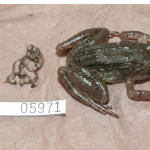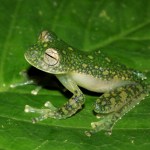discover
Male (left) and female L. Larvaepartus frogs discovered in Sulawesi, Indonesia. Image from Figure 2 of PLOS ONE article.
A new species of frog (Limnonectes larvaepartus) has been discovered in the rain forest of Sulawesi island in Indonesia. This species challenges the grade-school wisdom that taught us: 'frogs lay eggs'. It looks like textbooks will need to be revised as this is the only known exception to that rule. Study author Dr. Jimmy McGuire (University of California, Berkeley) said the following as quoted in Reuters, "Reproduction in most frogs could not be more…
Researchers in Peru have discovered four new species of tiny so-called "glass frogs" (family: Centrolenidae).
Centrolene charapita: with the yellow splotches on its back, this species was aptly named after little yellow chili peppers. Their hindlegs also had fleshy little zigzag-like protuberances whose purpose is unknown.
Figure 4 from Twomey et al. Zootaxa, 2014.
Cochranella guayasamini: This species is mostly green with yellow encircling its eyes. Interestingly, the tadpoles begin as a reddish pink color. Since they live in streambeds that are low in oxygen, this coloration…
Image of a big-eared bat from Scientific American
The New Guinea big-eared bat (Pharotis imogene; specimen pictured above) was thought to be extinct for the past 120 years. The bat is now considered critically endangered or possibly extinct as this specimen is the only known member of the genus. Since very little is known of this endangered bat, researchers who identified this specimen suggest that further research is needed to determine its abundance and distribution. With ongoing deforestation in New Guinea, this species may very well actually become extinct.
Source:
www.…
Photo Credit: Liew Thor-Seng
Ten new species of snails in the genus Plectostoma have been discovered in the limestone hills of Southeast Asia. Limestone hills are not common in this region, so the individual snail species are often isolated to just one hill. Therefore mining has threatened their existence and several species are already extinct or endangered.
Source:
LiveScience
Meet the first newly discovered mammalian species in 35 years, the olinguito, as presented by Rob Nelson from Untamed Science:
A ring-tailed lemur, via Afarensis
Here's one that'll grab you. Via Discover's 80beats science news blog:
A small, lemur-like creature may have been an early ancestor of monkeys, apes, and humans. A magnificently preserved fossil dating from 47 million years ago reveals an animal that had, among other things, opposable thumbs, similar to humans', and unlike those found on other modern mammals. It has fingernails instead of claws. And scientists say they believe there is evidence it was able to walk on its hind legs [ABC News].
This from a study to be published in PLoS ONE tomorrow, and which…
Today, we move to our new home at Discover Blogs: http://blogs.discovermagazine.com/intersection
While we have immensely enjoyed being a part of Scienceblogs, we've decided together that it is time to move on. Our tremendous thanks go out to Seed for hosting The Intersection since 2006 where we've been honored to share the network with such an esteemed community of bloggers--many of whom have become good friends.
While we're excited to join Carl, Phil, and Sean, it is a bittersweet decision as we will miss the Sb 'family' tremendously. Of course, we will never be far--the blogosphere has no…



